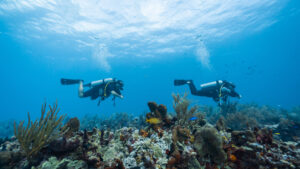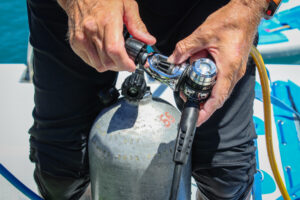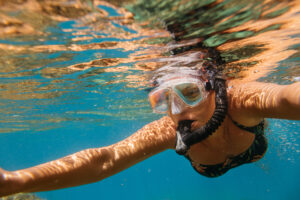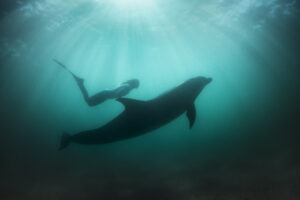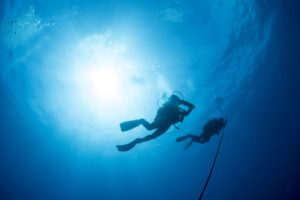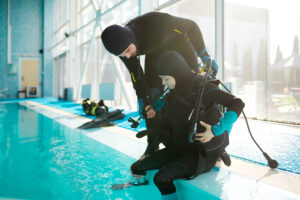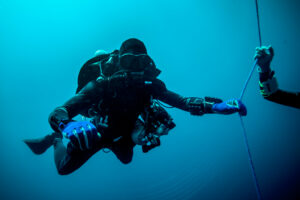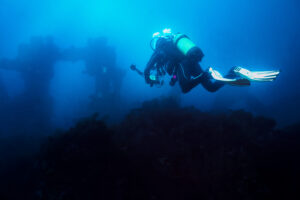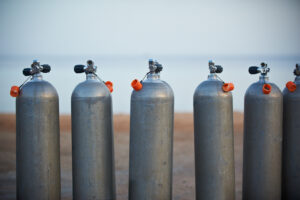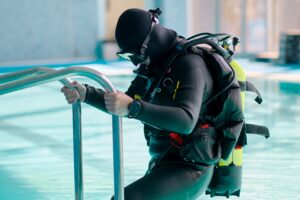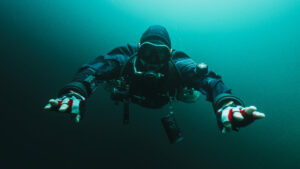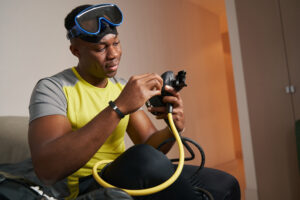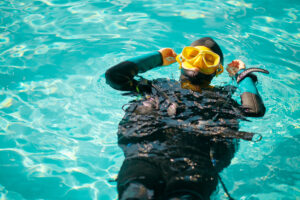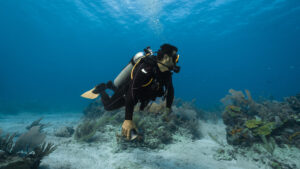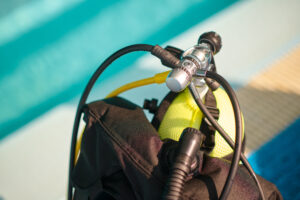ABLJ: Adjustable Buoyancy Life Jacket
Introduction to ABLJ
The Adjustable Buoyancy Life Jacket (ABLJ), alternatively known as a Buoyancy Compensator (BC) or Buoyancy Control Device (BCD), is an indispensable piece of equipment for divers. Utilized across a wide range of diving types, from recreational to commercial, this gear item plays a pivotal role in managing buoyancy underwater and ensuring the safety of the diver.
ABLJs originated from the military and commercial diving sectors before their adoption into recreational diving during the mid-20th century. Since then, their design and capabilities have evolved, keeping pace with the advancements in diving technology and expanding the horizons of human underwater exploration.
Functionality and Purpose of an ABLJ
An ABLJ is much more than a mere life jacket. It is a vital piece of equipment that affords divers the ability to regulate their buoyancy both underwater and at the surface, enabling them to achieve neutral, positive, or negative buoyancy as needed.
Neutral buoyancy is crucial for underwater navigation and exploration. Achieving this state allows divers to hover in the water without ascending or descending, making it easier to observe marine life, inspect underwater structures, or carry out scientific research. Positive buoyancy, on the other hand, is essential at the surface for resting, signalling, or in emergency situations where it’s crucial to stay afloat.
Anatomy of an ABLJ
Bladder
The heart of an ABLJ is its bladder – an inflatable bag that holds air to create buoyancy. In general, the bladder is constructed from tough, abrasion-resistant materials to withstand the rigors of diving.
When inflated, the bladder increases the diver’s volume in the water, decreasing their overall density and thus making them positively buoyant. Conversely, when the bladder is deflated, the diver’s volume decreases, increasing their density and causing them to sink or remain neutrally buoyant.
Inflation and Deflation Mechanisms
Managing the volume of air in the bladder is achieved through integrated inflation and deflation mechanisms. A low-pressure inflator, connected to the diver’s primary air source, allows for quick and easy inflation of the bladder.
On the other hand, deflation is facilitated through dump valves strategically located on the ABLJ. These valves can be manually operated or automatically triggered when the diver reaches a certain depth or the pressure in the bladder exceeds a set limit.
Types of ABLJs
ABLJs come in various designs, each tailored to suit different diving environments and diver preferences.
Jacket Style ABLJ
The Jacket Style ABLJ is the most common type of buoyancy compensator among recreational divers. This type of ABLJ encloses the diver’s torso like a vest, with the bladder wrapping around the waist and back.
When inflated, a Jacket Style ABLJ provides an even distribution of buoyancy around the diver, which can make it easier to stay upright at the surface. However, some divers may find this type of buoyancy distribution less desirable underwater, as it can create a tendency to tip forward.
Back-Inflation ABLJ
The Back-Inflation ABLJ, sometimes referred to as a “wing” BCD, features a bladder located primarily on the diver’s back. This design can offer a more streamlined profile underwater, reducing drag and providing better horizontal trim, making it a favorite among technical divers.
However, this style of ABLJ can create a tendency to tip backward at the surface when the bladder is fully inflated, which may require some adjustment for divers used to
Jacket Style ABLJs.
Adjustability and Fit
One of the defining features of an ABLJ, which also contributes to its name, is its adjustability. A well-fitted ABLJ provides comfort, enhances maneuverability, and can significantly improve the diving experience.
Straps and Buckles
ABLJs come equipped with adjustable straps and buckles. Typically, these are found on the shoulders, waist, and chest, allowing divers to customize the fit according to their body shape and size. The straps and buckles are designed to be easy to operate, even with gloved hands, and to stay secure under the pressures and rigors of diving.
Weight Integration
Many modern ABLJs also feature integrated weight systems. This system allows divers to carry the necessary weights for diving within the ABLJ itself, instead of wearing a separate weight belt. The weights can be easily inserted into pockets on the ABLJ and quickly released in an emergency situation.
Safety Features
While the primary function of an ABLJ is buoyancy control, it also incorporates several safety features designed to protect and assist the diver.
Overpressure Release Valves
These valves are an integral part of the ABLJ’s design. They automatically release air from the bladder if the pressure becomes too high – a situation that might occur during ascent, where decreasing ambient pressure could cause the air in the bladder to expand beyond its safe limit.
Quick-Release Mechanisms
ABLJs are designed with quick-release mechanisms, allowing divers to easily and swiftly remove the unit in an emergency situation. These mechanisms, usually located on the shoulder and waist straps, are designed to be fail-safe, ensuring the ABLJ can be discarded with a single pull of a handle or cord.
Maintenance and Care of ABLJs
Like all diving equipment, ABLJs require regular maintenance and care to ensure they remain in good working condition and provide reliable performance.
Routine Inspection
Before and after each dive, the ABLJ should be visually inspected for signs of wear and tear, such as fraying straps, cracked buckles, or punctures in the bladder. The inflation and deflation mechanisms should also be tested to ensure they’re operating correctly.
Cleaning and Storage
After a dive, especially in salt water, the ABLJ should be thoroughly rinsed with fresh water to remove salt, sand, and other potential contaminants that could corrode or damage the equipment. It should then be allowed to air dry completely in a shaded, well-ventilated area before being stored away.
In summary, the Adjustable Buoyancy Life Jacket is a key component of a diver’s gear. It offers control over buoyancy, adjustability for comfort, and safety features that add an additional layer of protection. With proper care and maintenance, an ABLJ can provide reliable service for many years, enhancing the joy and safety of diving.
Training and Mastery
While the mechanics of an ABLJ may seem straightforward, mastery of its use is an essential skill for any diver. Proper training ensures divers can effectively control their buoyancy and respond correctly in emergency situations.
Buoyancy Control Training
Every certified diver receives initial training on buoyancy control, including the use of an ABLJ, during their foundational diving courses. However, buoyancy control is a skill that benefits from ongoing practice and refinement. Some divers choose to take additional specialty courses focused on advanced buoyancy control to improve their comfort and efficiency underwater.
Emergency Procedures Training
Training also includes learning how to respond in the event of an emergency. This includes understanding how to ditch weights, how to achieve positive buoyancy rapidly at the surface, and how to assist another diver having difficulty with their ABLJ. Regular practice of these skills can significantly enhance diver safety.
Future of ABLJs
With advancements in technology and materials, the design and capabilities of ABLJs continue to evolve.
Materials and Sustainability
Modern ABLJs are being constructed with lighter, more durable materials that are resistant to the harsh conditions of diving. In addition, manufacturers are increasingly considering environmental sustainability in their designs, using materials that are recyclable or cause less environmental harm at the end of their lifecycle.
Technological Advancements
In terms of technology, future ABLJs might incorporate digital features such as integrated dive computers or heads-up displays. These could provide real-time information about buoyancy, depth, and dive time, further enhancing a diver’s control and situational awareness.
ABLJ: The Diver’s Essential
From its primary function of buoyancy control to its role in ensuring diver safety, the Adjustable Buoyancy Life Jacket remains a cornerstone of diving equipment. As a versatile tool, it serves the needs of divers across the spectrum, from the recreational to the professional. With continual innovations shaping its design and functionality, the ABLJ promises to retain its place as an essential component of the diver’s kit, contributing significantly to the exploration and enjoyment of the underwater world.
The ABLJ and Diving Disciplines
The Adjustable Buoyancy Life Jacket plays a crucial role across various diving disciplines. From recreational divers exploring coral reefs to commercial divers working on underwater construction projects, the ABLJ is a key piece of equipment.
Recreational Diving
Recreational divers constitute the largest group of users of ABLJs. These divers typically explore depths up to 40 meters and engage in activities such as underwater photography, wreck diving, and marine life observation. An ABLJ allows them to maintain neutral buoyancy effortlessly, thereby preserving their energy and providing a stable platform for activities like photography.
Technical and Cave Diving
In technical and cave diving, where divers venture beyond recreational diving limits and often into overhead environments, the role of an ABLJ becomes even more critical. The ability to maintain precise buoyancy control is crucial for safety and efficient navigation in these challenging environments.
Selecting an ABLJ
Choosing the right ABLJ involves consideration of several factors, each of which may influence the fit, comfort, and performance of the device.
Fit and Comfort
The ABLJ should fit snugly but comfortably, with enough adjustability to accommodate varying layers of diving suits. It is also important to consider the weight of the ABLJ, especially for divers who travel frequently.
Lift Capacity
The lift capacity of an ABLJ, which is the amount of weight it can offset at the surface, is another important consideration. This should be sufficient to support the diver, their gear, and any additional weight they might carry.
Conclusion
The Adjustable Buoyancy Life Jacket, while often overlooked in favor of more glamorous diving equipment, is integral to a safe and enjoyable diving experience. With the continued advancements in materials, design, and technology, the future of the ABLJ looks promising, promising to enrich the diving experience and open new avenues for underwater exploration and adventure.
ABLJ vs. Other Buoyancy Devices
While the ABLJ is the most common buoyancy device used in diving, there are other types of buoyancy devices that divers might encounter or choose to use based on their specific needs and diving practices.
Wings
Wings, similar to back-inflation ABLJs, are frequently used in technical and cave diving due to their streamlined profile and better trim control. They are also often used in twin-set configurations due to their larger lift capacity.
Sidemount Systems
Sidemount systems are a type of buoyancy device where the bladder is generally located on the diver’s back, but the gas cylinders are mounted alongside the diver rather than on the back. This system provides increased flexibility and gas redundancy, making it a popular choice for technical and cave divers.
The ABLJ in Diver Training
The use and mastery of an ABLJ is a fundamental skill taught in every basic scuba certification course. The ability to control buoyancy and understand the mechanics of an ABLJ is a foundational aspect of becoming a competent and safe diver.
Open Water Diver Training
During open water diver training, new divers learn the basics of using an ABLJ. This includes understanding how to achieve neutral buoyancy, how to adjust buoyancy at different depths, and how to use the ABLJ in emergency situations.
Advanced and Specialty Diver Training
As divers progress in their training and start to take on advanced and specialty courses, they will continue to refine their skills with an ABLJ. Courses such as Peak Performance Buoyancy or technical diving certifications place a high emphasis on perfecting buoyancy control using the ABLJ.
The Adjustable Buoyancy Life Jacket, in all its variations and with its numerous features, is an indispensable part of any diver’s kit. It is a testament to human ingenuity, enabling us to explore the underwater world with an unprecedented level of control and safety. As the field of diving continues to advance, so too will the design and functionality of the ABLJ, propelling us further into the depths of our planet’s final frontier.

